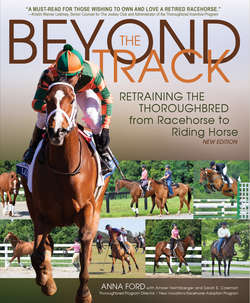Читать книгу Beyond the Track - Anna Morgan Ford - Страница 30
На сайте Литреса книга снята с продажи.
Becoming Breeding Stock
ОглавлениеAs mentioned, a mare with a decent race record or pedigree generally has value as a broodmare. A racehorse owner who is not involved in the breeding business will either sell the mare privately or through a breeding stock sale. However, a mare that does not have broodmare potential in the Thoroughbred industry may still be valuable for crossbreeding purposes—some wonderful sport horses have been the result of crosses with Quarter Horses, Paint Horses, Hanoverians, Oldenburgs, and American Warmbloods. Smaller Thoroughbred mares have become popular crosses with Welsh and other sport-pony breeds.
2.3 With so many Thoroughbred foals born each year and so few going on to successful racing careers, it is difficult to find caring homes for those retired from the track.
Unfortunately, only a small number of Thoroughbred stallions are retired to stud. The Thoroughbred breeding industry is very competitive and it is difficult, if not impossible, for a racehorse that does not have an impressive pedigree or race record to join these ranks. And, unlike mares, few Thoroughbred stallions are crossed with other breeds.
Early in training, a colt with a good pedigree may be left a stallion in case he proves successful on the track, although no matter how fabulous the bloodlines, if he becomes unmanageable, he’ll be gelded. Many colts with lesser pedigrees are gelded early on for just this reason—it makes them far easier to break and train to run. In direct relation to the value of the horses’ pedigrees, you will tend to find more geldings racing at smaller tracks and more colts racing at bigger tracks.
Stallions have been sent to New Vocations, ranging anywhere from three to nine years old, and in my experience they are easily transitioned to riding horses once they are gelded, probably because they were on the track and never actually used for breeding purposes.
